Cockatoo apistogram: varieties and tips for keeping
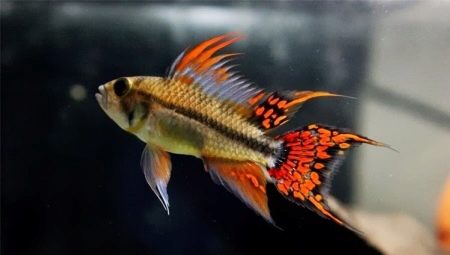
In most cases, people purchase home aquariums to observe the life and habits of underwater inhabitants, to relax after a hard day by contemplating the smooth movements of the fish. Therefore, hardly anyone wants to acquire a dull uninteresting inhabitant, merging in color with the ground or decorations. Most choose bright and beautiful pets, including the cockatoo apistogram.
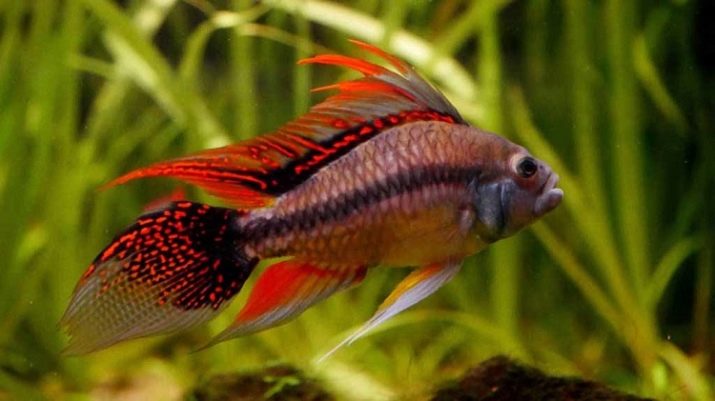
Description
The apistogram cockatoo is a small (5–10 cm) colorful fish belonging to the cichlov family. It looks like this:
- eyes are large, expressive;
- the lips are large, clearly defined, when grabbing food or catching prey, the cockatoo pulls them forward with a "tube";
- the color of the fish body can be very diverse: silvery, pinkish-mother-of-pearl, with a yellow-orange tint;
- a dark stripe runs along the side;
- fins are colored red, orange and even blue, full of spots and stripes;
- in males, the dorsal fin in front is decorated with long rays, reminiscent of the crest of a cockatoo parrot.
Important! The female differs from the male in the absence of a "tuft" and in a more modest color, as well as in size - she is almost half the size.
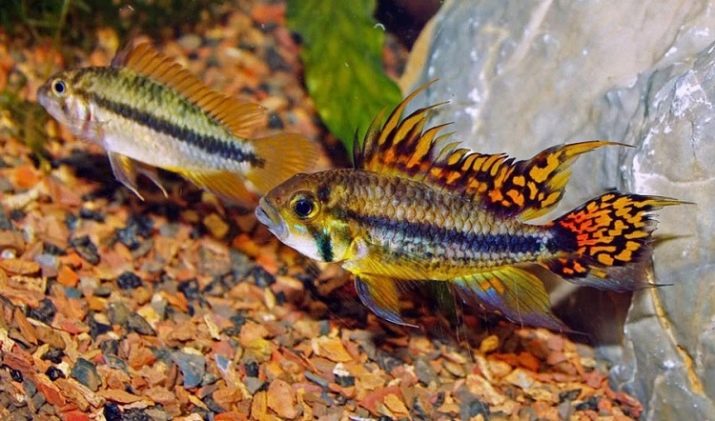
Views
Selection does not stand still, so the cockatoo apistogram did not stand aside. By breeding artificial varieties, the following colors were obtained, which gave the fish names:
- apistogram cockatoo dawn (sunset);
- solar flare (sunburst);
- double red (double ed);
- triple red (triple red);
- golden (gold);
- white gold (white gold);
- orange flash (orange flash);
- albino (albino).
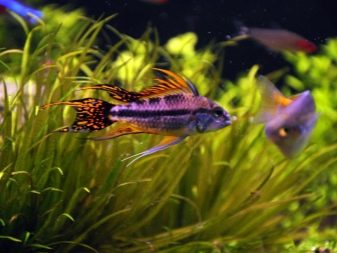

How to contain?
In order for your cockatoo fish to live happily ever after, you need to follow the recommendations for caring for them. Let's consider them in order.
Habitat
Cockatoo cichlids are most fond of water, which contains a large amount of dissolved oxygen. But various nitrogen compounds can harm the fish. Therefore, it is recommended to use a filter without fail, preferably an external one. It is desirable to maintain the acidity of the water at the level of 6–7.8 pH, and the hardness of 5–19 dGH.
The temperature must be kept within the range from +23 to +27 degrees Celsius. Cockatoo can tolerate a temporary decrease in performance to + 14– + 16 and an increase to +34 degrees. Aquaristic professionals advise changing the temperature of the water depending on the season, slightly lowering it in the winter.
In this way, you can strengthen the immunity of apistograms.


Choosing the right aquarium
Since group keeping is recommended (from 4 individuals: 1 male and 3 females), the minimum parameters of the tank should be 60x30x30 cm, volume - 50 liters. The more individuals you bring, the more you choose and the capacity.
By the way, the small size of the aquarium can lead to conflicts on the basis of the division of the territory, especially if there are 2 males in your flock of apistograms.

Arrangement of the aquarium
The apistogram cockatoo feels great surrounded by a large number of plants. Be sure to pay attention to decorating the bottom: lay out snags, various pebbles there, build grottoes from coconuts or broken pottery - female apistograms love to hide there. And also lay oak leaves on the ground, previously dried and soaked so that they do not float to the surface. By the way, coarse-grained sand is preferable as a soil. When it comes to lighting, a dim, diffused light is best, in which the cockatoo fish will look especially bright.
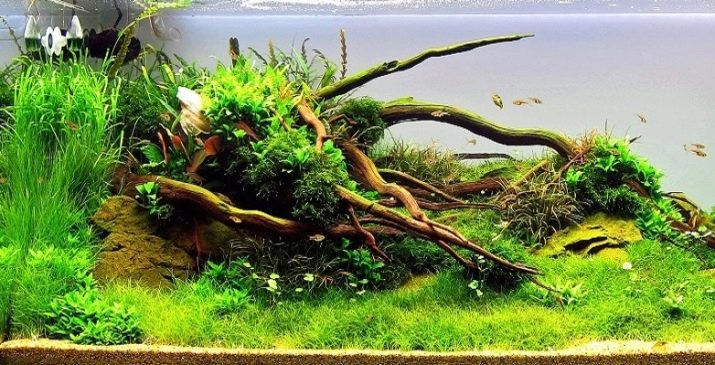
Feeding
Like other cichlids, the cockatoo apistogram is a predator. She especially loves benthic crustaceans, worms, plankton, bloodworms, tubifex. However, it is not always possible to get high-quality live food, and it can be difficult to store it, so teach your cockatoo fish to frozen food. In terms of nutritional value, they are not inferior to fresh ones, but they are much more convenient to store and use. Make sure that the selected food contains a high content of protein and that its particles drown, since the apistogram cockatoo prefers to catch them in the water, rather than collecting them from the surface.
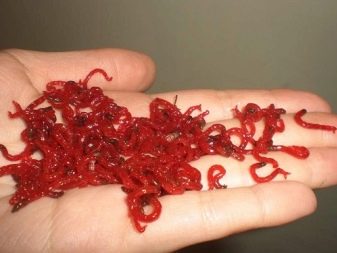
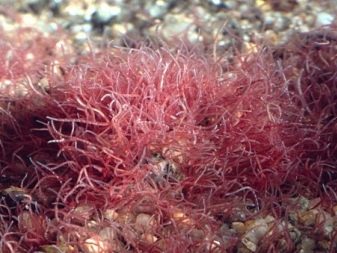
Possible diseases
The cockatoo cichlid is distinguished by strong immunity and resistance to disease, and is also famous for its ability to quickly recover from an illness. Perhaps the most common cockatoo apistogram disease is columnariasis or oral fungus. Its sign is the appearance of whitish cotton-like formations.
To cure fish from columnariasis, it is recommended to use trays with phenoxyethanol (up to 6 times).

Compatibility with other fish
The cockatoo apistogram, although it is a cichlid, is not as aggressive as other species, and by temperament it is a clear phlegmatic. The best "neighbors" in the aquarium will be fish that are similar in size and character: tetras, barbs, scalars, catfish-corridors, ancistrus, lalius, haracin. You can keep cockatoo together with live bearers: molly, swordtails, platies. Any “small fry” like zebrafish can be perceived by the apistogram as prey, so such a tandem is undesirable. And also it is not worth taking the risk and settling the cockatoo together with aggressors like discus, turquoise cancer, cichlazoma severum. But such cichlids as the princess of Burundi, the handsome chromis and the agassic apistogram will gladly settle with the cockatoo and will not fight with him.
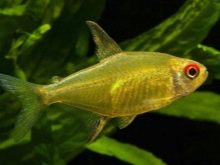
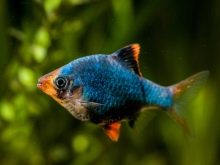

Breeding subtleties
Sexual dimorphism in the apistogram cockatoo is rather weak, but you can distinguish the female from the male by fins.As mentioned above, in "men" the "crest" on the dorsal fin is more pronounced, and on the caudal fin there are long "braids" that are absent in "women". The sizes of individuals also differ: a female in an aquarium can grow up to a maximum of 5 cm, while a male - all 10 cm. Fish become sexually mature at about 9-11 months. When forming a flock, it is important to take into account that there should be up to 5 females for one male. Cockatoo apistograms form a pair and begin mating games.
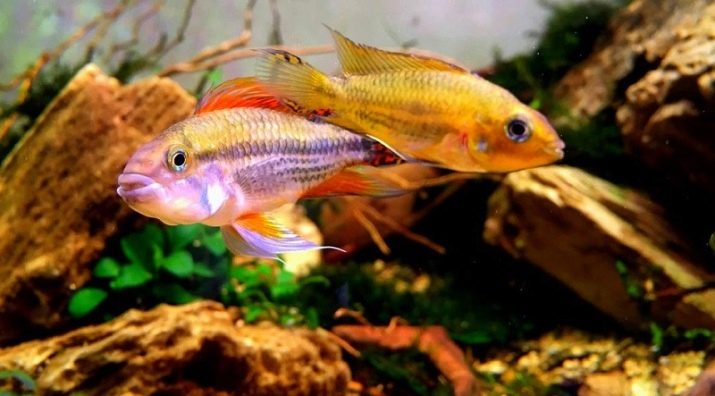
Before spawning, the female begins to jealously guard the selected area of the underwater world, driving away all her “girlfriends”, but not the male. When the time comes, the cockatoo apistogram forms a clutch of about 80 eggs. She does this in a secluded spot on a flat surface (it could even be the wall of the aquarium). The female takes care of the clutch, the male is guarding nearby. In order for the masonry to be as fruitful as possible, it is recommended to increase the softness of the water, as well as its temperature - up to +29 degrees Celsius. The medium must be acidic. After 4–5 days, eggs hatch and larvae appear. A little later they turn into fry and begin to move freely around the aquarium.
In order for the young to grow and develop successfully, it is very important to maintain a stable state of the surrounding aquatic environment during the first three weeks of life. Small cockatoo apistograms grow quite quickly. You can start feeding them with microscopic worms, "live dust", Artemia nauplii, and also feed them with boiled chicken egg yolks. Like any other living creature, the cockatoo apistogram needs care, proper feeding and compliance with the conditions of detention. You must understand that you have taken responsibility for an entire mini-ecosystem by acquiring an aquarium. If you do everything right and on time, the cockatoo apistogram will be able to delight you with its bright appearance and interesting behavior up to 5 years.
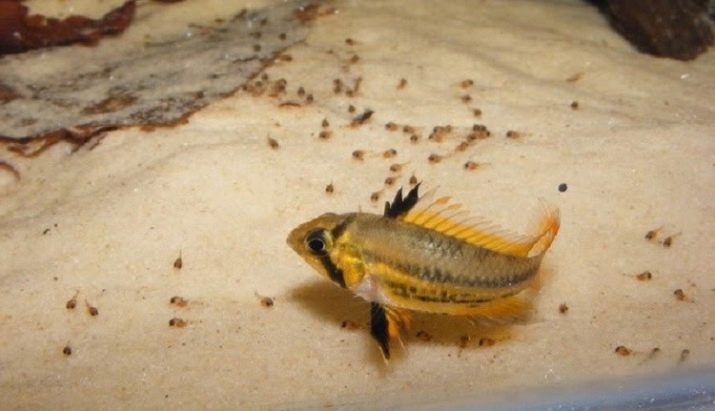
You can learn how to keep and breed Apistogram cockatoo fish from the video below.








